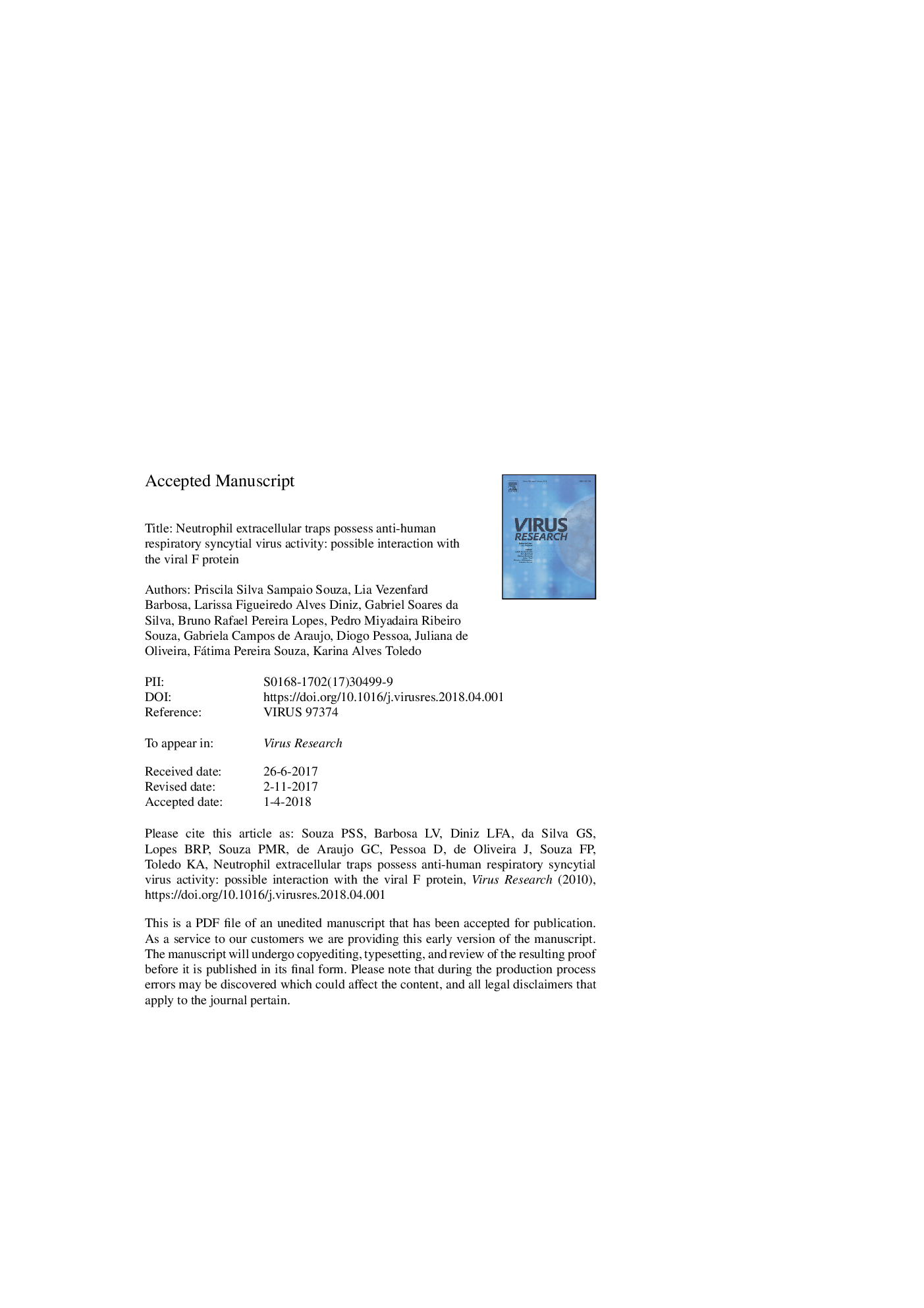| کد مقاله | کد نشریه | سال انتشار | مقاله انگلیسی | نسخه تمام متن |
|---|---|---|---|---|
| 8751777 | 1594306 | 2018 | 34 صفحه PDF | دانلود رایگان |
عنوان انگلیسی مقاله ISI
Neutrophil extracellular traps possess anti-human respiratory syncytial virus activity: Possible interaction with the viral F protein
دانلود مقاله + سفارش ترجمه
دانلود مقاله ISI انگلیسی
رایگان برای ایرانیان
کلمات کلیدی
موضوعات مرتبط
علوم زیستی و بیوفناوری
ایمنی شناسی و میکروب شناسی
ویروس شناسی
پیش نمایش صفحه اول مقاله

چکیده انگلیسی
Human respiratory syncytial virus (hRSV) is one of the main etiological agents of diseases of the lower respiratory tract, and is often responsible for the hospitalization of children and the elderly. To date, treatments are only palliative and there is no vaccine available. The airways of patients infected with hRSV exhibit intense neutrophil infiltration, which is responsible for the release of neutrophil extracellular traps (NETs). These are extracellular structures consisting of DNA associated with intracellular proteins, and are efficient in capturing and eliminating various microorganisms, including some viruses. hRSV induces the release of NETs into the lung tissue of infected individuals; however, the pathophysiological consequences of this event have not been elucidated. The objective of this study was to utilize in vitro and in silico assays to investigate the impact of NETs on hRSV infection. NETs, generated by neutrophils stimulated with phorbol myristate acetate (PMA), displayed long fragments of DNA and an electrophoretic profile suggestive of the presence of proteins that are classically associated with these structures (elastase, cathepsin G, myeloperoxidase, and histones). The presence of NETs (>2â¯Î¼g/ml) in HEp-2 cell culture medium resulted in cellular cytotoxicity of less than 50%. Pre-incubation (1â¯h) of viral particles (multiplicity of infection (MOI) values of 0.1, 0.5, and 1.0) with NETs (2-32â¯Î¼g/ml) resulted in cellular protection from virus-induced death of HEp-2 cells. Concurrently, there was a reduction in the formation of syncytia, which is related to decreased viral spread in infected tissue. Results from western blotting and molecular docking, suggest interactions between F protein of the hRSV viral envelope and BPI (bactericidal permeability-increasing protein), a microbicidal member of NETs. Interactions occurred at sites important for the neutralization and coordination of the hRSV infection/replication process. Our results showed that the presence of NETs decreases hRSV-induced cellular damage, possibly by directly affecting viral particle capture and/or interfering with the fusion activity of the F protein. These findings broaden the understanding of the role of NETs during hRSV infection.
ناشر
Database: Elsevier - ScienceDirect (ساینس دایرکت)
Journal: Virus Research - Volume 251, 2 June 2018, Pages 68-77
Journal: Virus Research - Volume 251, 2 June 2018, Pages 68-77
نویسندگان
Priscila Silva Sampaio Souza, Lia Vezenfard Barbosa, Larissa Figueiredo Alves Diniz, Gabriel Soares da Silva, Bruno Rafael Pereira Lopes, Pedro Miyadaira Ribeiro Souza, Gabriela Campos de Araujo, Diogo Pessoa, Juliana de Oliveira, Fátima Pereira Souza,